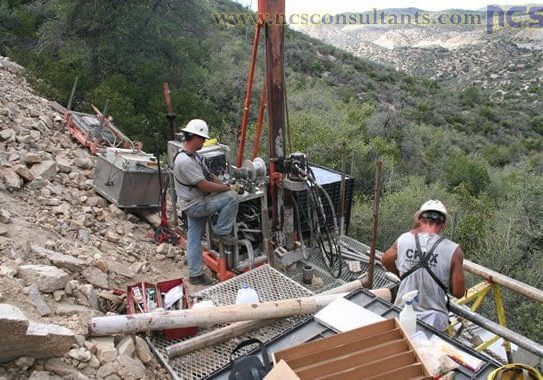US 60: Pinto Valley
Location: Gila County, AZ
Client: Kimley-Horn and Associates, Inc. & ADOT
Status: Completed

NCS Consultants, LLC (NCS) was retained by Kimley-Horn and Associates, Inc. (KHA) and the Arizona Department of Transportation (ADOT) to develop geotechnical recommendations for new side-hill fill slopes associated with the widening of the US 60 roadway between County Line and Pinto Valley Road in Gila County, Arizona. The overall project limits extend from MP (Mile Post) 236.13 to MP 239.50 along US 60. Specifically, NCS’ work was limited to development of recommendations for three fill slopes, F1, F2 and F3, located east of the Pinto Creek Bridge between approximately MP 238 and MP 239.
Various options were considered for the fill slopes, including unreinforced soil slopes (USS), reinforced soil slopes (RSS), and mechanically stabilized earth (MSE) walls. These slope retention alternatives were considered alone and in combination with each other based on the geotechnical stability of existing and proposed slopes, earthwork balance requirements, space constraints, constructability, environmental and aesthetics considerations. In mid 2006, the project team identified 2H:1V slopes as a feasible alternative that could satisfy most design considerations.
The existing fill slopes are at an inclination of approximately 1.5H:1V and are plated with boulders of varying sizes. Some of these slopes are up to 150-ft high. These fill slopes are porous and convey water as evidenced by the presence of mature trees and vegetation on the existing fill slopes. Based on the field and laboratory investigations performed by NCS, these fill slopes can best be described as marginally stable from a geotechnical stability viewpoint. In other words, the factor of safety (FS) of the existing fill slopes against slope instability is close to unity. ADOT Materials Group requires a minimum FS of 1.5 for any slope retention alternative. Considering that the existing slopes are marginally stable, this ADOT requirement essentially means that the overall slope stability needs to be increased from approximately 1.0 to 1.5 or greater. Such an increase in FS requires extraordinary measures in the design and construction of the new fill slopes.
Detailed global stability analyses were performed for the three sites, and recommendations to the design team to achieve the minimum factor of safety of 1.5 included benching the slopes to increase the resisting forces to a global (deep-seated) failure scenario, various drainage recommendations including geocomposite drains, french drains, and outlet pipes. Finally, a geosynthetic reinforced platform was recommended near the surface to maintain the stability of the roadway.
This project is completed.
- Existing fill slopes are 1.5H:1V, up to 150-ft tall, and marginally stable (Factor of Safety close to 1.0)
- Detailed global stability analyses
- Recommendations to achieve a Factor of Safety of 1.5
- Slope drainage determined to be very important


